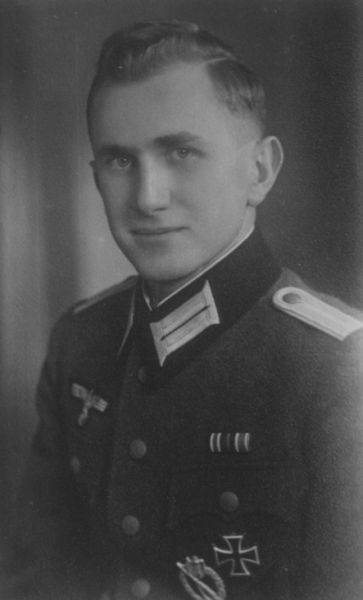Wenz, Alfred Emil
- Date of birth:
- December 1st, 1919 (Berghausen/Baden, Germany)
- Date of death:
- September 19th, 1944
- Nationality:
- German
Biography
Aflred Emil Wenz died of severe wound in a hospital on 19th September 1944. He was buried on the Heldenfriedhof of Tome, Latvia (approx. 35 km southeast of Riga).
Ptomotions:
1st December 1940: Oberschütze, 9./Infanterie-Regiment 435
1st June 1941: Gefreiter, 9./Infanterie-Regiment 435
1st July 1942: Unteroffizier
1st December 1942: Feldwebel and O.A. at the same time to Leutnant
1st May 1944: Oberleutnant der Reserve
1st September 1944: Hauptmann der Reserve (posthumous and retroactive)
Do you have more information about this person? Inform us!
- Period:
- Second World War (1939-1945)
- Unit:
- Heeresunteroffiziersschule Treptow-Rega
- Awarded on:
- November 1st, 1939
- Period:
- Second World War (1939-1945)
- Rank:
- Gefreiter
- Unit:
- 9. / Infanterie-Regiment 435
- Awarded on:
- February 19th, 1942
- Period:
- Second World War (1939-1945)
- Rank:
- Gefreiter
- Unit:
- 9. / Infanterie-Regiment 435
- Awarded on:
- April 1st, 1942
Silver version.
- Period:
- Second World War (1939-1945)
- Rank:
- Leutnant (2nd Lieutenant)
- Unit:
- 11. / Grenadier-Regiment 435
- Awarded on:
- August 18th, 1942
- Period:
- Second World War (1939-1945)
- Rank:
- Leutnant (2nd Lieutenant)
- Unit:
- 11. / Grenadier-Regiment 435
- Awarded on:
- January 1st, 1943
- Period:
- Second World War (1939-1945)
- Rank:
- Leutnant (2nd Lieutenant)
- Unit:
- 1. / Grenadier-Regiment 435
- Awarded on:
- June 23rd, 1943
- Period:
- Second World War (1939-1945)
- Rank:
- Leutnant (2nd Lieutenant)
- Unit:
- 11. / Grenadier-Regiment 435
- Awarded on:
- January 1st, 1944
- Period:
- Second World War (1939-1945)
- Rank:
- Leutnant (2nd Lieutenant)
- Unit:
- 11. / Grenadier-Regiment 435
- Awarded on:
- April 12th, 1944
- Period:
- Second World War (1939-1945)
- Rank:
- Leutnant (2nd Lieutenant)
- Unit:
- Führer 11. / Grenadier-Regiment 435
- Awarded on:
- May 17th, 1944
Anerkennungsurkunde led to the awarding of the Ehrenblattspange.
- Period:
- Second World War (1939-1945)
- Rank:
- Leutnant (2nd Lieutenant)
- Unit:
- Führer 11. / Grenadier-Regiment 435
- Awarded on:
- May 17th, 1944
- Period:
- Second World War (1939-1945)
- Rank:
- Oberleutnant (1st Lieutenant)
- Unit:
- 7. / Grenadier-Regiment 435
- Awarded on:
- August 20th, 1944
- Period:
- Second World War (1939-1945)
- Rank:
- Oberleutnant (1st Lieutenant)
- Unit:
- Chef 7. / Grenadier-Regiment 435
- Awarded on:
- September 21st, 1944
“During the hard combat south of Riga the Bolsheviks achieved a penetration in the lines of our bridgehead at Bauske. A Württemberg-Baden Grenadier-Bataillon was dispatched for a counterattack. In the heavy enemy fire all the officers of the Bataillon fell out save for the 24 year-old Oberleutnant Alfred Wenz (from Berghausen, near Karlsruhe). At this point he had not yet fully recovered from his last wound, and was only back at the front on account of his own wish. Now he took over leadership of the Bataillon.
Strong Bolshevik fire ceaselessly hammered the ranks of the Grenadiers. However Oberleutnant Wenz personally intervened wherever his attack came to a halt. He gave individual squads instructions for continuing the attack and directed the Bataillon’s crossing over a river. Then he was once again in the foremost line, inspiring the Grenadiers forward. His men inflicted heavy losses on the foe and had pushed them back a considerable distance by the time darkness fell.
Yet the right neighbouring Bataillon was unable to maintain the same rate of advance under the Bolshevik’s defensive fire. Oberleutnant Wenz realized that his Bataillon’s success might be compromised if the Bolsheviks were not also thrown back in the neighbouring sector. Although the day’s efforts had severely sapped his strength (his old wound caused him pain with every movement), he decided to act. He took control of 10 Grenadiers and assailed the Bolshevik positions. Although the defenders had plenty of automatic weapons on hand he was able to roll up the enemy line over a 800 metre distance during the course of a ferocious two-hour struggle. His Grenadiers captured 21 machine guns over the course of swirling close combat and inflicted heavy losses on the foe. Their commander personally captured 17 prisoners. Only small numbers of Soviet riflemen were able to escape.
After this supreme effort the strong of the young officer finally gave out. A messenger supported him as he painstakingly limped back to his Bataillon. But during the night he did not allow himself any respite. He oversaw the defense against the enemy counterattacks that were swiftly set into motion, and he remained on his feet until he was able to hand over command of the Bataillon the next morning.”
Preliminary award document dated on 25th September 1944.
Sources
- Photo 1: H.-P. Rackete
- - Fellgiebel W.P., Elite of the Third Reich, The recipients of the Knight's Cross of the Iron Cross 1939-1945: A Reference, Helion & Company Limited, Solihull, 2003, ISBN 1-874622-46-9
- Award certificates, Documents, Photos and Werhpass via H.-P. Rackete
- Bonner Nachrichten: Tageszeitung für Bonn und Umgegend














